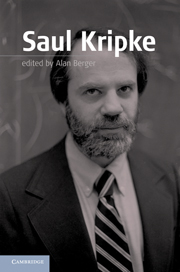Book contents
- Frontmatter
- Contents
- List of Contributors
- Introduction to Kripke
- Part I Naming, Necessity, and Apriority
- Part II Formal Semantics, Truth, Philosophy of Mathematics, and Philosophy of Logic
- 5 Kripke Models
- 6 Kripke on Truth
- 7 Kripke on Logicism, Wittgenstein, and De Re Beliefs about Numbers
- 8 Kripke on the Incoherency of Adopting a Logic
- Part III Language and Mind
- Part IV Philosophy of Mind and Philosophical Psychology
- Index
- References
6 - Kripke on Truth
Published online by Cambridge University Press: 05 June 2012
- Frontmatter
- Contents
- List of Contributors
- Introduction to Kripke
- Part I Naming, Necessity, and Apriority
- Part II Formal Semantics, Truth, Philosophy of Mathematics, and Philosophy of Logic
- 5 Kripke Models
- 6 Kripke on Truth
- 7 Kripke on Logicism, Wittgenstein, and De Re Beliefs about Numbers
- 8 Kripke on the Incoherency of Adopting a Logic
- Part III Language and Mind
- Part IV Philosophy of Mind and Philosophical Psychology
- Index
- References
Summary
Introduction
Saul Kripke’s “Outline of a Theory of Truth” (1975) has been the most influential publication on truth and paradox since Alfred Tarski’s “The Concept of Truth in Formalized Languages” (1935). It is thick with allusions to related unpublished work, and the present account will provide some information on this additional material, but the ubiquitously cited “Outline” must remain the main focus in the limited space available.
Liar sentences
Let us dispose at the outset of the potentially distracting issue of the bearers of truth. Suppose Y says, “What X just said is true,” and Z asks, “But what did X say?” Then Y may answer with either a direct or an indirect quotation of X, perhaps saying, “X said, ‘Snow is white,’ and that’s true,” or perhaps saying, “X said that snow is white, and that’s true.” Since it seems that a direct quotation denotes a sentence while a that-clause denotes a proposition, it seems that Y is attributing truth in one case to the sentence X uttered and in the other to the proposition X thereby asserted.
Keywords
- Type
- Chapter
- Information
- Saul Kripke , pp. 141 - 159Publisher: Cambridge University PressPrint publication year: 2011

